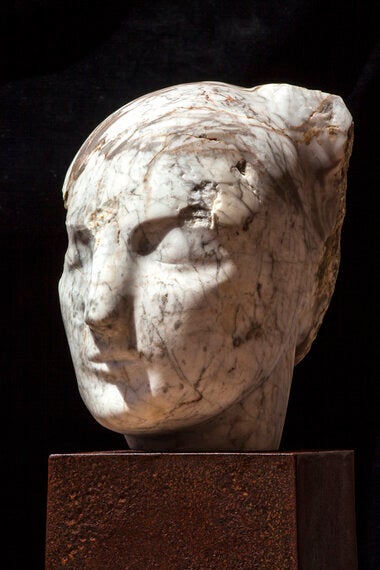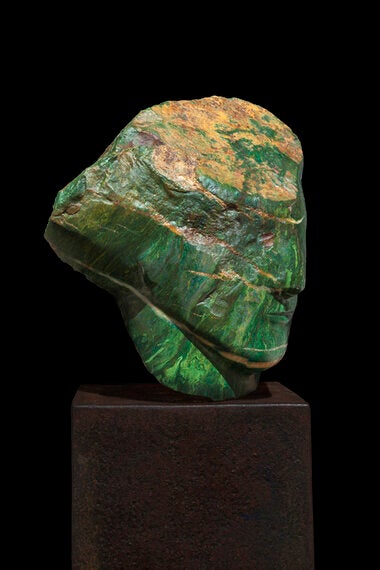Emily Young is regarded as Britain's greatest living stone sculptor. Not for her the pristine slabs of Carrara marble. She revels in those ragged off-cuts that lay at the back of old stone quarries near her home in Tuscany, sometimes wearing, as she puts it, dark overcoats of disguise.
Then she will chip off a corner and discover the rich, complex and beautiful patterns that nature and time, the greatest sculptors of all, have created. Her job, she believes, is to shape, polish and lay bare this natural beauty whether by chiselling or diamond cutting. Using traditional classical free carving skills, her trademark is to sculpt a human face on to the ancient rock, reaffirming the sacred relationship between the living world and Mother Nature.

Geological accidents are at the heart of her work. There may be blue veins as in Rosea Marble Head of a Woman (above), crevasses where air bubbles once existed millions of years ago, ripples of colour caused by mineral deposits, fissures by geological trauma.
At her wonderful new exhibition, Emily Young: Call and Response London, at The Fine Art Society, I spoke to the artist about her work and began by asking her whether putting a human face on these stones is a way of celebrating the natural world and our dependence on it?
"It's incredibly personal for me - I just love doing it. I don't put an expression on the faces - it's always contemplative, quiet and timeless. The world is in a very sorry state in many parts and a lot of terrible things are going on and I think a lot of that is based on a lack of respect for the material world that we're exploiting for our benefit and that's robbing us of our future. What I feel is that we've lost our sense of humility towards the great mother that is our creator which is the Earth and the solar system and the universe. We are not separate, we don't have power over the earth, we are utterly dependent on it and many of the great religions of the past spoke of this. In my culture, there's huge arrogance about the rights that we have to exploit the resources of the earth."
BC: Do you think that by sculpting and enhancing the beauty of nature, you are making your contribution to the green cause?
"Yes, and I'm also very aware that the future is a very long way away, and apparently the future is much longer than the past. These stones were born way in the past, and also they will endure. So when we look at previous cultures, the things that have endured are the stone things. Leather and wood just doesn't last. Some of my pieces, for example, are made of quartzite and quartzite is next to diamonds in hardness and these will endure for billions of years."

BC: Your sculptures such as this (Verdite Forest Head, above,) have extraordinary deep colours and amazing patterns.
"This is an African stone called Verdite. It's volcanic and you can see that it has many metals that have melted and stirred. There's so much beauty here, it's like looking into a forest or looking down from a satellite photo. There are these patterns that repeat and repeat. There could be green swamps full of algae or something. There could be rivers or clouds. There's a purple colour - how beautiful. Sunsets, blue water running. I just wanted to give it a face, for the Earth also has a kind of much ancienter, quieter consciousness but there is something there that we can love, respect and have a sense of awe for in all its manifestations.

BC: Again, this piece, (Primavaro Torso, above), made from onyx, has extraordinary marks and patterns.
"Here you can see little blocks of stone that were in another form once. These blocks of white were smashed up by a volcano erupting or possibly an earthquake. As they resettle, little bits of carbon come in. The green is of calcium carbonate mixed with silicates. A lot of water has allowed these tiny, tiny mineral deposits to stick together before evaporating. It's stalagmitic and stalactitic, and there's an air bubble and you can see crystals growing. There's a lot of iron in here. From that you can deduce that water got in later carrying iron with it from another place because elsewhere there is no iron, just white and green."
BC: It's a whole history of the earth.
"This is what I'm saying. Be conscious of the history of the earth. I think it' s a good alternative to the way we are looking at the earth at the moment which is that it's there for us to plunder. We don't put back what we take out until we've used it. How could we possibly be doing this? I'm interested in psychoanalysis as well. Part of growing up is that you leave your infantile dependent. You have a voracious appetite and you want your mother to give what you want when you want it. You scream if you don't get it and you really think you're going to die. So we have a lot of that still. As a species, we've moved into adulthood but are still behaving like babies. We have instant appetites that require instant gratification. We want more and more and more. We have to get beyond that and behave more responsibly like an individual adult. Leave that stuff behind and say I'm responsible for children now, my appetites and needs need to be put on the back burner for a bit. I can organise this but it's not going to be all about me, it's going to be about the future."
BC: So the human race has to grow up.
"Big time."
Emily Young: Call and Response London is showing at The Fine Art Society, 148 New Bond Street, London W1S 2JT until 27 August.
The images are used with the permission of the artist at The Fine Art Society, London.